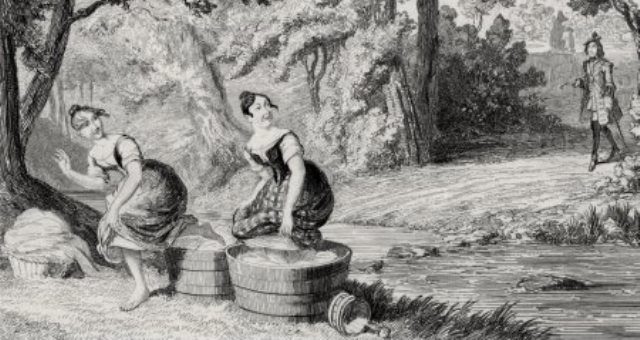Spring Cleaning: Hygiene in Colonial Times
Ah, spring. A new beginning. New possibilities. Let’s start fresh with a good bath. Wash the winter off of our bodies. Dress in freshly laundered clothes. And…wait. What? You shower every day no matter the season? You always have clean clothes? This is no big deal? Ah, 21st century people you surely are. Certainly not 18th century American colonials. For them, a bath was a huge ordeal and the population didn’t know the meaning of hygiene. Body odor was a fact of life, forever wafting from the skin and deeply embedded into clothing.
Can you picture the fancy silk shirt and velvet coat of a gentleman? And the beautiful silks, brocades and damasks worn by the ladies of fashion in the mid- 1700s? Try to imagine these graceful garments in a perpetually non-laundered state being worn by unwashed bodies and, well, you get the picture. Of course, there were accessories, too. Like the all-important lace handkerchief, that itty-bitty piece of lavender-scented material daintily brought to the nose to hide the stench coming from fellow colonials.
Why the stink? There were a few reasons.
Highest on the list was the thought of the time period. It was believed that washing removed important oils from the skin, which left the person vulnerable to disease. So really, the colonials thought it was unhealthy to bathe. I can only say I’m glad we evolved beyond that train of thought. Once in a while, those in that generation would wash their hands or face but everything else? Not so much.
Mid-Atlantic colonials might have bathed three or four times a year. New Englanders, on the other hand, may have only accomplished a body wash once a year. It was too cold to slip into a tub more often than that in their climate. One can only imagine the smell inside a Boston tavern or meeting hall as the patrons had heated discussions on such-life changing ideas as independence from England. I can picture those hankies waving about in the fervor of the times, but we all know what those hankies were really doing.
However, even if they were like us today and wanted a daily bath, it would have been an arduous, time consuming ordeal. We jump in the shower with its handy-dandy indoor plumbing, with temperature controlled running water, we use all the scented products on the market to help us along with the task, step out and towel off. We get dressed in our clean clothes and go about our lives. Back then, though, it began with preparing a fire, filling tubs of water from the nearest water source (be it a well, stream, river, etc.) and lugging them to the fire to heat. When warm, the heavy tubs had to be lugged again, this time to the washing vessel. It took a few hours to get to that point alone. Oh, and was the bathing area private? Most likely not. Now that could be an uncomfortable and compromising situation!
If they were lucky enough to have some harsh, homemade lye soap available, they used it. If not, just the water would have to do. After bathing, they used some linen or whatever other piece of material they had to dry off. No fancy Egyptian luxury cotton or Peruvian pima cotton towels hung in their bathroom. Heck, they didn’t even have a bathroom!
Bathing was a family affair. The standard practice was that the men of the household bathed first, followed by the women and then the children. By the time the baby was put into the tub, the water was so dirty and murky that “don’t throw the baby out with the bathwater” was a warning to be taken literally.
After all of this, the water tub had to be hauled away and dumped. But the deed was done and the person or the family was, to a point, clean—at least until they got dressed in the same, dirty, smelly clothes. Laundry day was another laborious task that would be beyond our patience in this day and age, but the colonial American way of washing clothes is a subject for another day.

